When most people think of Nevada, they think of Las Vegas, gambling, and entertainment. The Silver State became famous due to its prominence as an early mining destination and later as a hub for tourists looking to have some fun in “Sin City.” Still, when some people think of Nevada they tend to conjure images of scorching deserts and arid badlands. After all, the state is full of natural beauty and is also home to many plants and animals including desert bighorn sheep and rattlesnakes. At the same time, Nevada is home to a diverse array of spiders. From giant tarantulas to tiny orb weavers, here is a picture preview of 10 spiders in Nevada that you can find throughout the Silver State.
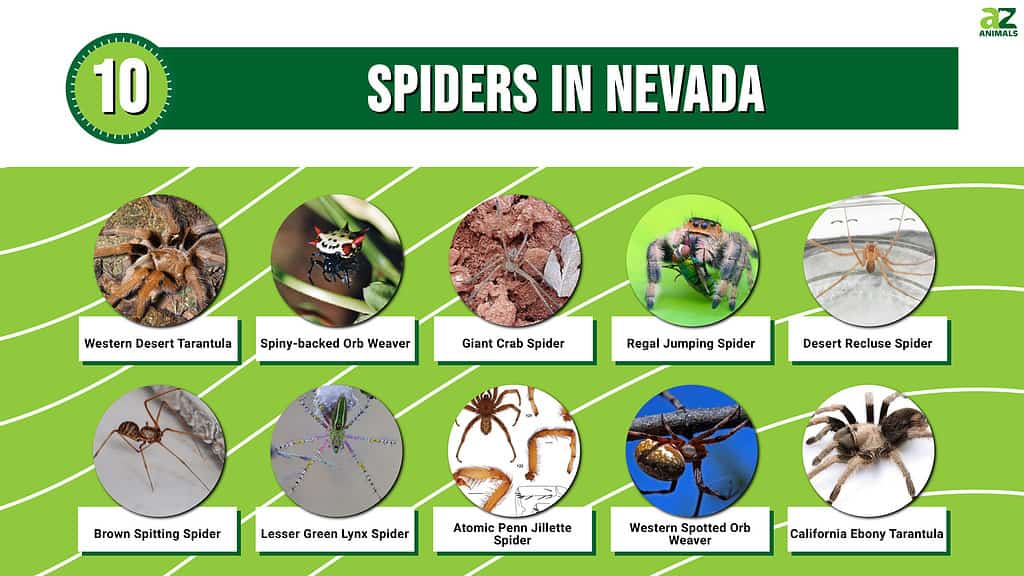
Now read on to learn more information about these Nevada spiders, including size and behaviors.
#10: California Ebony Tarantula
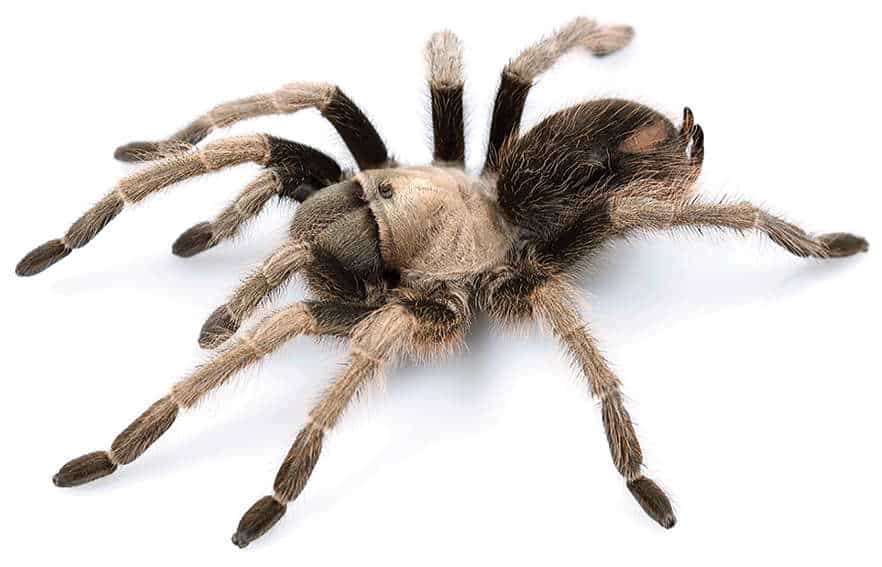
Female California ebony tarantulas can live up to 25 years of age.
©Chris A. Hamilton, Brent E. Hendrixson, Jason E. Bond / Creative Commons – License
The California ebony tarantula, Aphonopelma eutylenum, belongs to the tarantula family Theraphosidae. Outside of California, you can also find these spiders in Nevada, Arizona, and parts of Mexico.
Female California ebony tarantulas can grow up to 5 inches long with their legs extended while the males measure noticeably smaller. Their bodies come in various shades of brown ranging from light to dark to ebony, hence their name. Typically, the cephalothorax appears lighter than the abdomen.
California ebony tarantulas hide in burrows during the day and emerge at night to hunt. They rely on speed and stealth to ambush prey which includes large insects and other spiders. Female California ebony tarantulas can live extremely long lives and are capable of reaching up to 25 years old.
#9: Western Spotted Orb Weaver
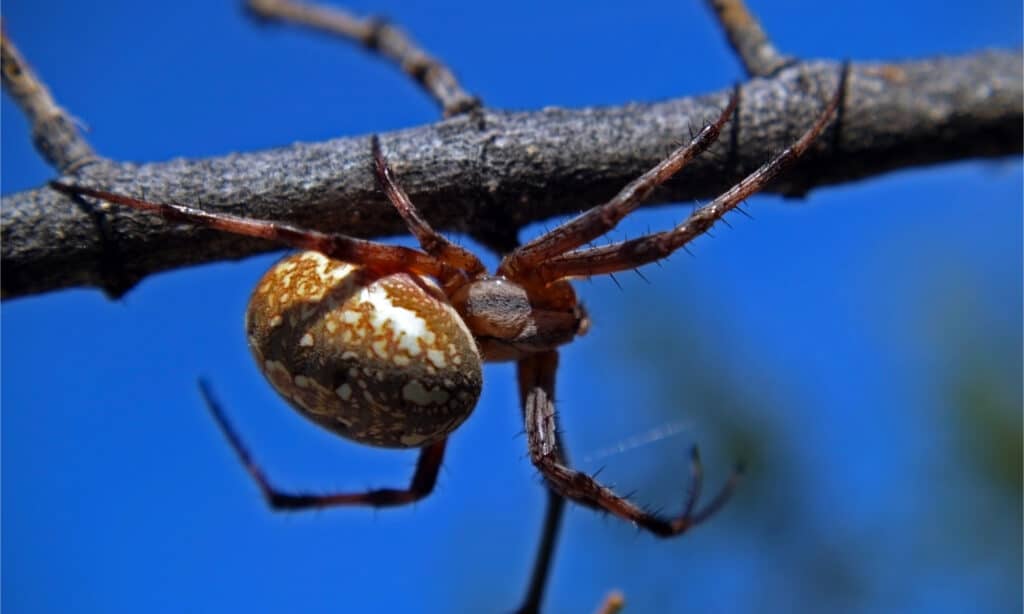
Western spotted orb weavers spins a large, circular web.
©Deep Desert Photography/Shutterstock.com
Neoscona oaxacensis, or the western spotted orb weaver, belongs to the orb-weaver family Araneidae. You can find these large web-weaving spiders in Nevada as well as throughout the western United States, South America, and the Galapagos Islands.
Adult females measure between 9 and 18 millimeters long and adult males measure 6 to 13 millimeters long. They come in a range of colors although they typically possess a large black or grey abdomen covered in cream-colored spots, hence their name. Additionally, a thin, whitish-yellow line with wavy borders runs down the length of the dorsal side of the abdomen.
Like other orb weavers, the western spotted orb weaver spins a large, circular web. It tends to hang upside down in its web and wait for prey to stumble into the sticky threads. Despite its large size, its bite poses little threat to humans. Symptoms normally include only mild pain and swelling.
#8: Atomic Penn Jillette Spider

The Atomic Penn Jillette spider is named after the famous magician, Penn Jillette.
©Jason Bond, Auburn University / Creative Commons – License
Aptostichus pennjillettei, or the Atomic Penn Jillette spider, gets its name from the famous magician, Penn Jillette. It was first identified by a team from Auburn University back in 2013 after the team began sifting through specimens collected from the nuclear test site in Mercury, Nevada, back in 1962. Its location makes it one of the few spiders in Nevada that grew up in an area bathed by radiation from nuclear blasts.
The largest specimens measure about 25 millimeters long with females typically measuring larger than males. They appear predominantly rust-colored and possess long, curved legs. Meanwhile, the thin, elongated abdomen appears more tan or beige with darker brown markings.
Like other trapdoor spiders, Atomic Penn Jillette spiders hide in burrows and spin webs across the entrance to both keep out predators and capture prey. Despite their large size, they pose little danger to humans.
#7: Lesser Green Lynx Spider

The lesser green lynx spider often gets confused with the more well-known green lynx spider.
©De19/Shutterstock.com
Peucetia longipalpis is better known as the lesser green lynx spider. You can find these visually stunning spiders in Nevada as well as throughout the United States and as far south as Venezuela.
In terms of appearance, lesser green lynx spiders greatly resemble the more well-known green lynx spider, Peucetia viridans. That said, lesser green lynx spiders tend to have shorter, fatter abdomens and less pronounced abdominal markings. Additionally, they also sport white hairs on their abdomens and have shorter legs compared to viridans.
Like other members of its family, Oxyopidae, the lesser green lynx spider does not a web to catch its prey. Instead, it ambushes insects that are attracted to flowers such as bees, wasps, and butterflies. Its bite is not medically significant despite its large size.
#6: Brown Spitting Spider
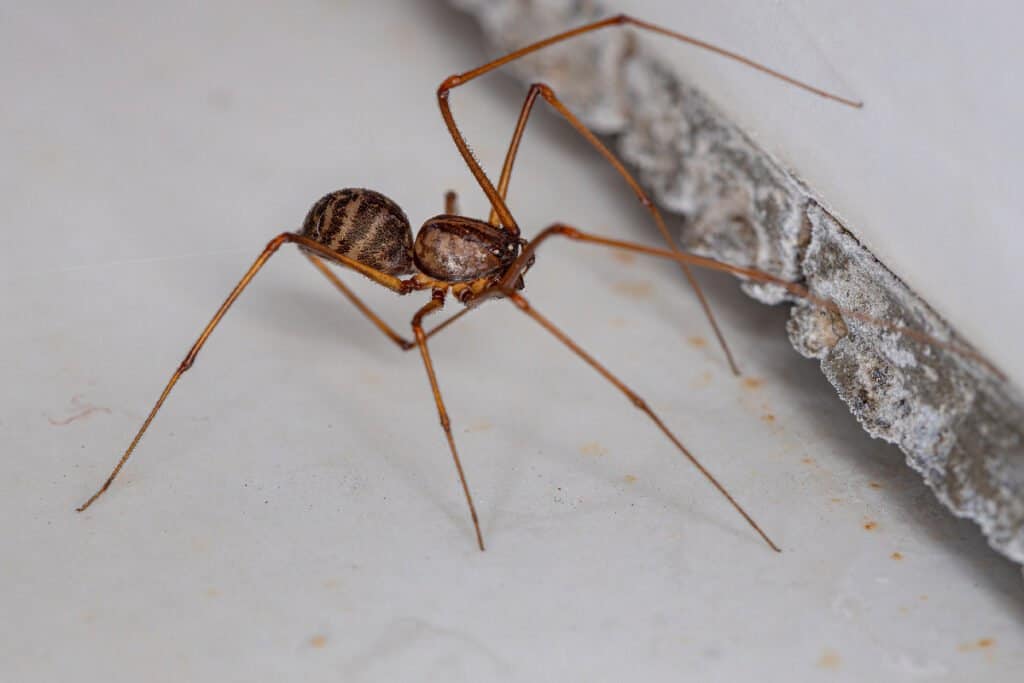
The brown spitting spider catches prey with venomous silk that it shoots from its abdomen.
©iStock.com/ViniSouza128
The brown spitting spider, Scytodes thoracica, belongs to the spitting spider family Scytodidae. This cosmopolitan spider lives not only in Nevada but in countries throughout the world and on every continent except Antarctica.
Adult brown spitting spiders measure between 3 and 6 millimeters long with females measuring larger than males. Unlike most other spiders, they possess 6 rather than 8 eyes. The carapace points distinctively upward while the abdomen slopes downward. They appear predominantly light brown or tan and feature darker brown markings on the bodies and legs.
Brown spitting spiders use one of the most unique methods of catching prey of all the spiders in Nevada. Instead of using webs, they slowly stalk their prey and then fire venomous threads that immobilize their target. They can fire the threads from up to 10 millimeters away and fire in a zigzag pattern to increase their area of impact.
#5: Desert Recluse
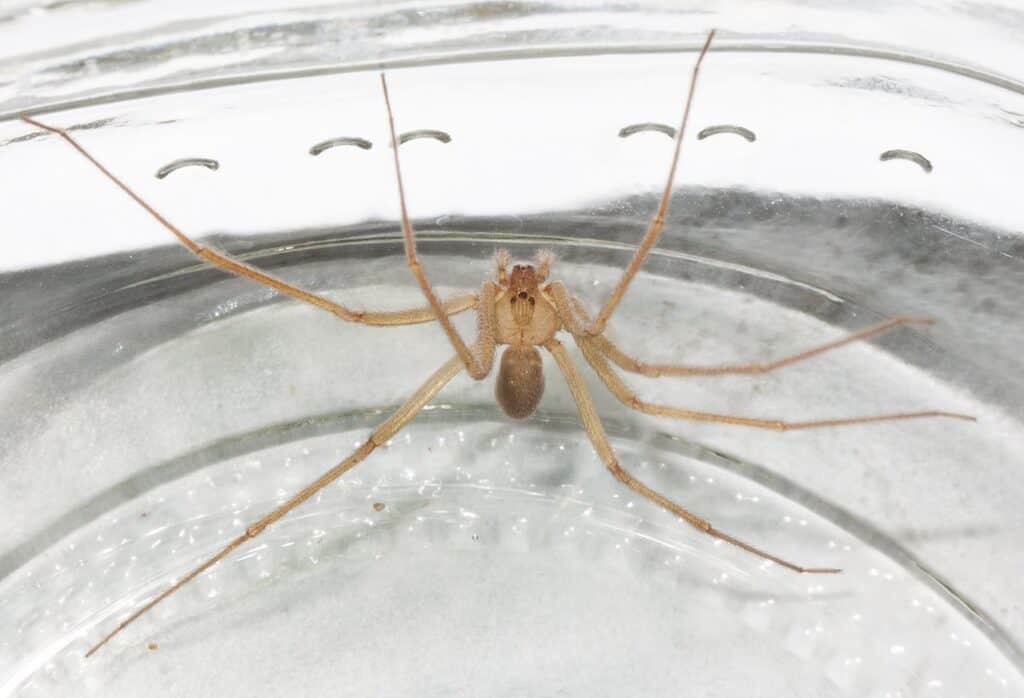
The desert recluse produces necrotic venom that can cause skin lesions.
©DesertTrip / CC BY-SA 4.0, via Wikimedia Commons – License
The desert recluse, Loxosceles deserta, is one of the most venomous spiders in Nevada. It ranges throughout the southwestern United States as well as Mexico. People sometimes mistake it for its close cousin the brown recluse despite the fact that the two do not live in close proximity to one another.
Adult desert recluses measure about 12 millimeters long and nearly 50 millimeters with their legs extended. Unlike most spiders, both females and males measure around the same size. They appear predominantly tan aside from the abdomen which appears light brown. You can identify them thanks to the characteristic violin-shaped marking on the cephalothorax.
Desert recluse spiders are active hunters that leave their irregularly-shaped cobwebs in order to hunt for food. Like other members of their family Sicariidae, they possess necrotic venom that can cause skin lesions, pain, nausea, vomiting, and fever.
#4. Regal Jumping Spider
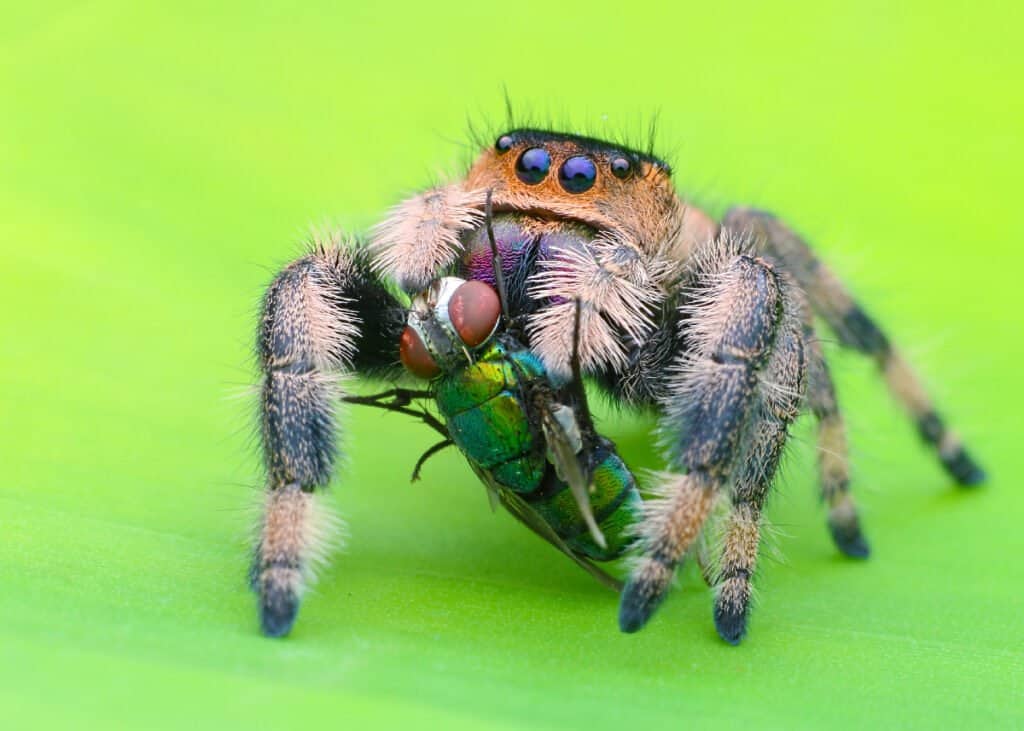
The regal jumping spider is the largest species of jumping spider found in the eastern United States.
©Farid Irzandi/Shutterstock.com
Phidippus regius, or the regal jumping spider, is one of the largest jumping spiders in Nevada. While it normally ranges throughout the eastern United States it is one of the most popular jumping spiders kept in captivity. For this reason, you can find it throughout much of the United States.
Female regal jumping spiders measure from 7 to 22 millimeters long and males measure 6 to 18 millimeters long. While females vary in color from grey to reddish-orange, the males typically look black with white spots and stripes. That said, both sexes feature three dots on their abdomens that form the image of a smiling face.
Regal jumping spiders do not use webs to catch insects. Instead, they jump on their prey from a distance and then deliver a killing blow with their large, iridescent mouthparts. Although they pose little threat to humans their bite can be quite painful.
#3. Giant Crab Spider
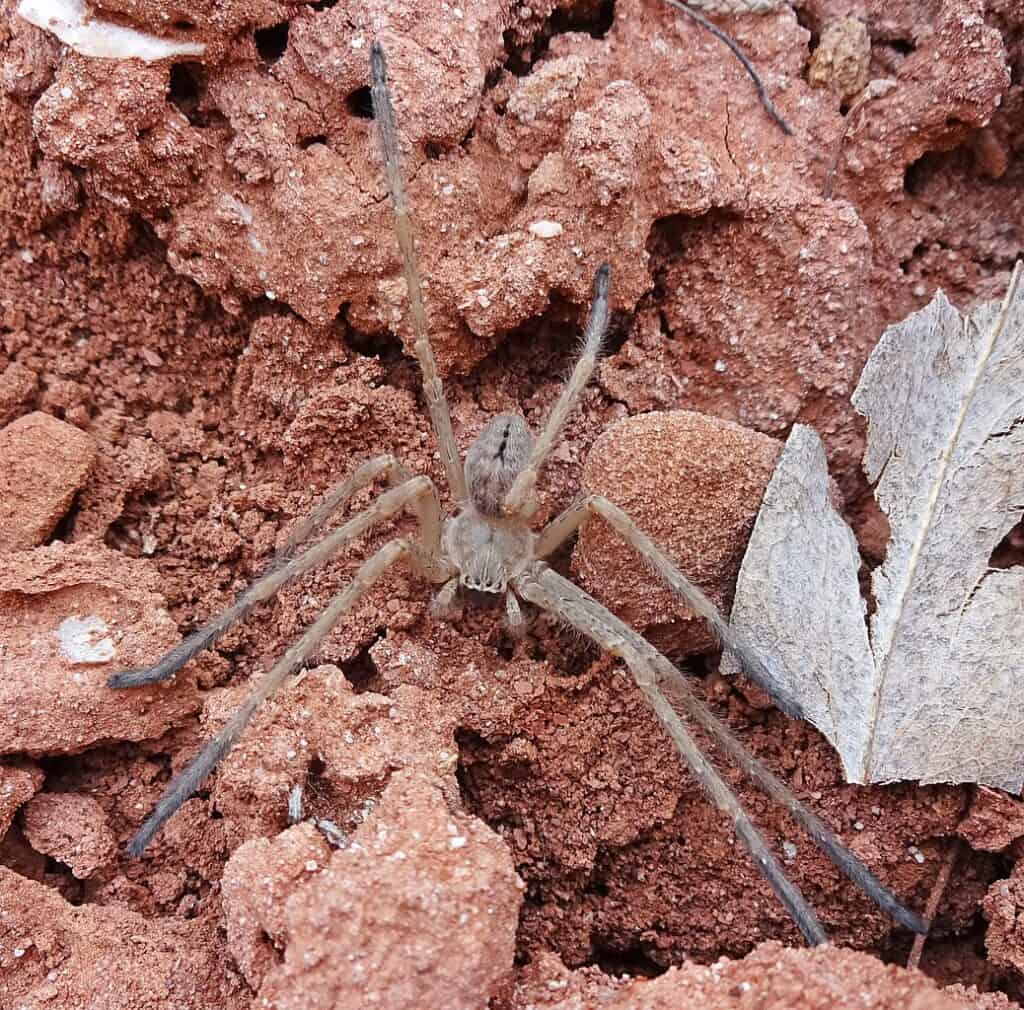
The giant
crab spider
can grow up to 6 inches long with its legs extended.
©Andrey Zharkikh from Salt Lake City, USA / CC BY 2.0, via Wikimedia Commons – License
The giant crab spider, Olios giganteus, belongs to the giant crab or huntsman spider family Sparassidae. It easily ranks as one of the largest spiders in Nevada. It ranges throughout the western and southwestern United States and tends to prefer warm, drier climates.
Adult giant crab spiders can grow up to 6 inches long with their legs extended. That said, their bodies typically only measure up to 20 millimeters long. Their bodies appear predominantly light brown and their color tends to grow darker near the end of their legs. They feature a black marking on the abdomen that looks like an elongated letter Y.
Like other huntsman spiders, giant crab spiders do not build webs to capture prey. Instead, they actively hunt large insects and other spiders. They can act quite aggressively, particularly when protecting their offspring. Additionally, their bite is quite painful and may cause nausea, headaches, and swelling.
#2: Spiny-Backed Orb Weaver

The spiny-backed orb weaver is also called the star spider due to its spiky appearance.
©iStock.com/Weber
The spiny-backed orb weaver, Gasteracantha cancriformis, is the second member of the family Araneidae to make our list of spiders in Nevada. It also goes by the names thorn spider, star spider, kite spider, or jewel spider due to its shape. It tends to live in warm, wooded areas throughout the New World.
Females measure between 5 and 9 millimeters long and nearly 10 to 13 millimeters wide. Meanwhile, males measure significantly smaller and typically only reach 2 to 3 millimeters long. The females feature bright red spines on their white and black abdomens, hence their name. On the other hand, males do not possess spines and look drabber in appearance.
Spiny-backed orb weavers construct orb-shaped webs that they use to capture prey. Many people consider them beneficial given that they primarily prey on garden pests and other insects. Their bite is of little to no medical significance.
#1. Western Desert Tarantula

The western desert tarantula is quite docile as a pet.
©Ryan M. Bolton/Shutterstock.com
The western desert tarantula, Aphonopelma chalcodes, is another tarantula to make our list of spiders in Nevada. It also goes by the names Arizona blonde tarantula and Mexican blonde tarantula. As you can imagine from its moniker, it ranges throughout the southwestern United States and northern Mexico.
Adult western desert tarantulas measure between 8 and 13 centimeters long with females measuring larger than males. Females appear almost completely light tan, hence their name “blonde tarantulas.” Meanwhile, possess black legs, a reddish abdomen, and a copper cephalothorax.
Despite their size, western desert tarantulas have earned a reputation for being quite docile which makes them popular pets. During the day, they hide under rocks to avoid the scorching sun and emerge at night to actively hunt prey. Given their lack of aggression they rarely bite people and most bites are relatively harmless given their lack of potent venom.
Summary of 10 Spiders in Nevada:
| Rank | Species | Location |
|---|---|---|
| 10 | California Ebony Tarantula | California, Nevada, Arizona, and parts of Mexico |
| 9 | Western Spotted Orb Weaver | The western United States, South America, and the Galapagos Islands. |
| 8 | Atomic Penn Jillette Spider | Nevada |
| 7 | Lesser Green Lynx Spider | Throughout the United States and as far south as Venezuela. |
| 6 | Brown Spitting Spider | Throughout the world and on every continent except Antarctica. |
| 5 | Desert Recluse | Throughout the southwestern United States as well as Mexico |
| 4 | Regal Jumping Spider | Throughout the eastern United States |
| 3 | Giant Crab Spider | Throughout the western and southwestern United States |
| 2 | Spiny-Backed Orb Weaver | All over the world in tropical and subtropical climates |
| 1 | Western Desert Tarantula | The southwestern United States and northern Mexico. |
The photo featured at the top of this post is © iStock.com/waldru
Thank you for reading! Have some feedback for us? Contact the AZ Animals editorial team.






